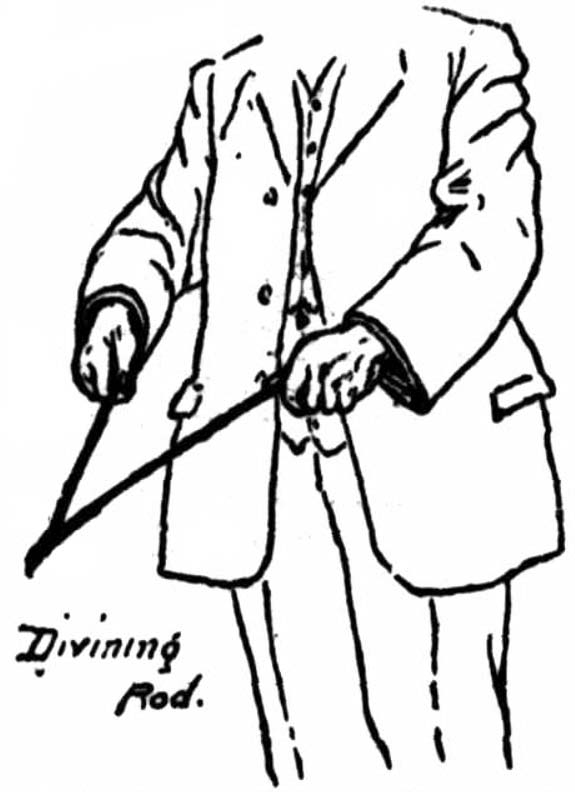Emphatic declarations of faith
On the subject of water divining, water witching, or dowsing, as it is variously known, there is a wide difference of opinion.

Emphatic declarations of faith
On the subject of water divining, water witching, or dowsing, as it is variously known, there is a wide difference of opinion.

On the one hand there are those who believe in the efficacy of the rod, and who can claim that, as one authority puts it, "It is well known that there are people who are able, with the help of the rod, to indicate places where water can with certainty be found". On the other hand are the sceptics, whose views are represented by one who described the extensive literature on the subject of water divining as "a whole library of learned rubbish; jargon for charlatans; marvellous tales for fools; and amusement for antiquarians".
Such emphatic declarations of faith may not find favour entirely with all the adherents of either class, and, indeed, there is yet a third class, to which I shall refer later. The fact remains, however, that the man on the land, when he wishes to locate a site for a well, very frequently resorts to the use of the divining rod, and the matter is one of such general interest as perhaps to provide excuse for further writing upon an already over written theme.
By rod is meant not only the hazel twig, or ash, oak, willow, or any other form of stick, forked or straight; but also metal rods, straight, bent, or looped; pendulums, watch springs, suspended balls, or pieces of cane or whalebone tied together. In all these forms the rod has been used, and, though the action naturally is different, motion of an appliance of some kind has been taken as affording an indication of the presence of what ever is being sought.
As to what can be found by using a rod, and as to the causes of its action, some striking, perhaps one may even say extraordinary, assertions have been made by its supporters, among whom must certainly be included two modern French writers, le Vicomte Henry de France and Henri Mager, whose books, entitled "The Modern Dowser" and "Water Diviners and their Methods", were published in 1930 and 1931 respectively.
Brief quotations from these authors will serve to make clear their point of view. M. le Vicomte states: "The dowser's art ... depends on scientific theories similar to those which account for wireless telegraphy. Not only can minerals and metals be traced by its (the rod's) aid, but also faults and cavities... Quite recently a still more remarkable application has been successfully attempted. The rod is now used to examine the physical condition, and to diagnose the disease of plants, minerals, and human beings. Recent experiments carried out under strict control leave no doubt on this point. Among the curious instances of divining successes quoted in the book are the following: (1) 'A dowser undertook to reclassify a lot of bottles saved from a bombardment; he distinguished Bordeaux from Burgundy, and did not mistake a bottle of water from one of gin'. (2) 'Professor Rosset, University of Lausanne, succeeded in determining the vitality, fecundity, and vigour of numerous fowls in an important poultry farm'.
M. le Vicomte states: "The illustrious Chevreul in 1812 gave his opinion that the movements of the rod are purely subjective, the dowser being their in voluntary author. Until our own time this has remained the opinion of almost the whole scientific world... In electricity rather than in unknown forces is to be found the source of the remarkable phenomena or the rod. We must insist on this point that our detective instrument is our own body, our nervous system, and not, as superficial observers thought, the rod or pendulum. Our body plays fairly accurate the part of a wireless receiving instrument."
M. Mager defines a 'sourcier', or dowser, as one who claims to have special means for discovering springs(sources). He states that a good dowser must have extensive knowledge of physics, chemistry, geology, and hydrology, and 'must have touched also on that science of tomorrow, which deals with the constitution of matter, and the essence of physical manifestation.
His idea of the working of the rod is that "when the point of the rod encounters the flux of force which forms the immense field bordering the flux on both sides, a discharge passes through the head and one branch of the rod. The earth providing a path for a return current, the two branches of the rod, which form an angle, are traversed by currents opposite in direction, and, according to Ampere's laws, repelling one another : The two branches which are bound to one an other try to free themselves : they exert force; they visibly 'work'".
Such are the views of two enthusiastic champions of the rod. but It can not be said that their explanations of the reasons for its working carry much conviction : Rather indeed they appear to leave openings for the weapons of the sceptic. And yet, after all, one cannot afford to be too dogmatic in a matter which is still but imperfectly understood. Such appears at least to be the attitude of two eminent authorities.
By H. M. Dare, M. Inst. C.E.
Nambour Chronicle 4 September 1936